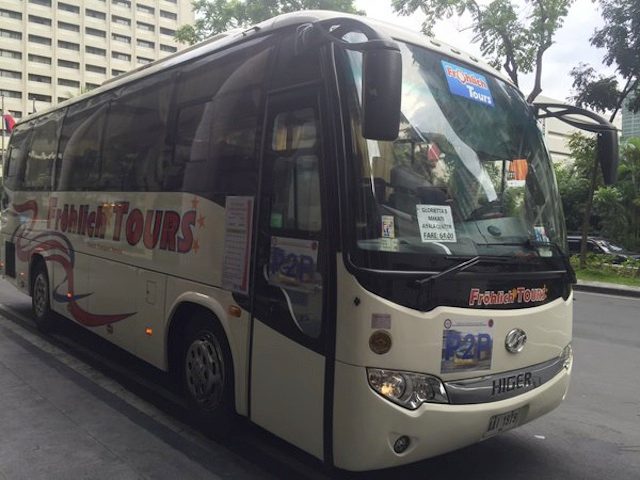SUMMARY
This is AI generated summarization, which may have errors. For context, always refer to the full article.

MANILA, Philippines – With guaranteed seating and buses that depart on time – with or without passengers – the government’s recently-launched premium point-to-point (P2P) bus service aims to convince car owners that taking the bus can be comfortable, fast, and cheap.
While the first few days of the non-stop premium bus service saw few passengers last December, passengers have been steadily increasing thanks to word of mouth and positive feedback, according to P2P bus operator Chris Bauer, CEO of Froehlich Tours.
The new service currently operates along 3 routes in Metro Manila, carrying passengers from Quezon City and Mandaluyong City straight to the Makati central business district without any stops. Buses depart on time based on a fixed schedule, whether or not the vehicles are full.
Bauer said the new service offers a bus experience that most commuters don’t normally expect in their daily EDSA commute. The bus schedule allows commuters to plan their day and estimate how long it will take to travel to their destination. Passengers also get guaranteed seats and free WiFi onboard.
Please be advised that the Premium Point to Point Bus Service will extend operations beyond January 6.
Skeptics may say the new service won’t significantly cut travel time because the buses still ply the notoriously traffic-choked EDSA. But the Department of Transportation and Communications (DOTC) believes that skipping the bus stops along the 23.9-kilometer thoroughfare already translates to 20 to 30 minutes of time saved in traffic.
“On a normal city bus, it takes around an hour or more to travel from SM North EDSA in Quezon City to Makati City. The premium bus can get you there within 35 to 45 minutes because you skip the bus stops along EDSA, each of which adds at least a minute to normal travel time,” said Cep Garcia, technical assistant at the DOTC.
During rush hour, all 15 units for the P2P service run to full capacity, carrying about 800 passengers in the morning and 600 during the evening.
Because of the high demand, the Land Transportation Franchising and Regulatory Board (LTFRB) is planning to add another route and extend the bus service until January 31.
‘Win-win solution’
The DOTC’s push to increase bus ridership aims to decongest EDSA and speed up travel time along the thoroughfare.
The P2P service is one of the agency’s efforts to convince car owners to take the bus instead. One premium bus can take about 30 private cars off EDSA, according to DOTC Senior Adviser for Planning Robert Siy.
An initial survey among P2P passengers also found that about 20% of passengers are car owners who shifted to the new service, said LTFRB Chairman Winston Ginez. All of the passengers surveyed by the agency also said they will ride the buses again.
Aside from a comfortable and faster ride, Bauer said passengers can also expect a safer riding experience because drivers are paid fixed wages instead of the current commission system. (READ: How to solve traffic? Fix bus system, pay drivers fixed wages)
“Our drivers have a fixed salary of about P30,000 a month, and they have social benefits…We pay them that amount whether or not the bus only has one passenger, so they don’t have to compete with other buses to pick up passengers,” Bauer said.
‘Operators should work together’
The fixed wage system may be good for bus drivers and passengers’ safety, but is it sustainable for operators?
Bauer said the P2P system is a long-term investment – operators can’t expect to earn profits in just weeks of operations.
“I see the return on investment schedule between 5 to 7 years. But then you have good quality buses and educated drivers, and you establish long-term city operations,” Bauer said.
Siy noted that other bus operators are “cautious” about taking a risk with the P2P system. Most are still studying and observing how the current system will fare.
But he added that operators are also looking for a win-win solution that can help them improve their services and reduce the complaints they get from the riding public.
With positive feedback from passengers, Bauer said he hopes other operators will also adopt the P2P model to help improve the megacity’s bus system. (READ: To improve traffic in 2016, DOTC to overhaul bus, jeep systems)
“What’s missing in the Philippines is bus operators working together,” Bauer said. “I would like 10, 20 more operators to do this, to say yes, let’s work together, let’s set standards together.” – Rappler.com
Add a comment
How does this make you feel?
There are no comments yet. Add your comment to start the conversation.